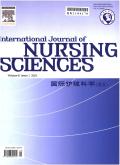Identifying the key influencing factors of psychological birth trauma in primiparous women with interpretable machine learning
IF 3.1
3区 医学
Q1 NURSING
引用次数: 0
Abstract
Objective
Accurately identifying the key influencing factors of psychological birth trauma in primiparous women is crucial for implementing effective preventive and intervention measures. This study aimed to develop and validate an interpretable machine learning prediction model for identifying the key influencing factors of psychological birth trauma in primiparous women.
Methods
A multicenter cross-sectional study was conducted on primiparous women in four tertiary hospitals in Sichuan Province, southwestern China, from December 2023 to March 2024. The Childbirth Trauma Index was used in assessing psychological birth trauma in primiparous women. Data were collected and randomly divided into a training set (80 %, n = 289) and a testing set (20 %, n = 73). Six different machine learning models were trained and tested. Training and prediction were conducted using six machine learning models included Linear Regression, Support Vector Regression, Multilayer Perceptron Regression, eXtreme Gradient Boosting Regression, Random Forest Regression, and Adaptive Boosting Regression. The optimal model was selected based on various performance metrics, and its predictive results were interpreted using SHapley Additive exPlanations (SHAP) and accumulated local effects (ALE).
Results
Among the six machine learning models, the Multilayer Perceptron Regression model exhibited the best overall performance in the testing set (MAE = 3.977, MSE = 24.832, R2 = 0.507, EVS = 0.524, RMSE = 4.983). In the testing set, the R2 and EVS of the Multilayer Perceptron Regression model increased by 8.3 % and 1.2 %, respectively, compared to the traditional linear regression model. Meanwhile, the MAE, MSE, and RMSE decreased by 0.4 %, 7.3 %, and 3.7 %, respectively, compared to the traditional linear regression model. The SHAP analysis indicated that intrapartum pain, anxiety, postpartum pain, resilience, and planned pregnancy are the most critical influencing factors of psychological birth trauma in primiparous women. The ALE analysis indicated that higher intrapartum pain, anxiety, and postpartum pain scores are risk factors, while higher resilience scores are protective factors.
Conclusions
Interpretable machine learning prediction models can identify the key influencing factors of psychological birth trauma in primiparous women. SHAP and ALE analyses based on the Multilayer Perceptron Regression model can help healthcare providers understand the complex decision-making logic within a prediction model. This study provides a scientific basis for the early prevention and personalized intervention of psychological birth trauma in primiparous women.
应用可解释机器学习识别初产妇心理分娩创伤的关键影响因素
目的准确识别初产妇心理分娩创伤的关键影响因素,对实施有效的预防和干预措施至关重要。本研究旨在开发和验证一个可解释的机器学习预测模型,以识别初产妇心理分娩创伤的关键影响因素。方法对2023年12月至2024年3月在四川省四所三级医院的初产妇进行多中心横断面研究。分娩创伤指数用于评估初产妇的心理分娩创伤。收集数据,随机分为训练集(80%,n = 289)和测试集(20%,n = 73)。六种不同的机器学习模型进行了训练和测试。使用线性回归、支持向量回归、多层感知机回归、极端梯度增强回归、随机森林回归和自适应增强回归等6种机器学习模型进行训练和预测。基于各种性能指标选择最优模型,并使用SHapley加性解释(SHAP)和累积局部效应(ALE)对其预测结果进行解释。结果在6个机器学习模型中,多层感知器回归模型在测试集中表现出最好的综合性能(MAE = 3.977, MSE = 24.832, R2 = 0.507, EVS = 0.524, RMSE = 4.983)。在测试集中,多层感知器回归模型的R2和EVS分别比传统线性回归模型提高了8.3%和1.2%。与传统线性回归模型相比,MAE、MSE和RMSE分别下降了0.4%、7.3%和3.7%。SHAP分析显示,产时疼痛、焦虑、产后疼痛、恢复力和计划妊娠是影响初产妇心理分娩创伤的最关键因素。ALE分析表明,较高的产时疼痛、焦虑和产后疼痛评分是危险因素,而较高的弹性评分是保护因素。结论可解释性机器学习预测模型可识别初产妇心理分娩创伤的关键影响因素。基于多层感知器回归模型的SHAP和ALE分析可以帮助医疗保健提供者理解预测模型中的复杂决策逻辑。本研究为初产妇心理分娩创伤的早期预防和个性化干预提供了科学依据。
本文章由计算机程序翻译,如有差异,请以英文原文为准。
求助全文
约1分钟内获得全文
求助全文
来源期刊

International Journal of Nursing Sciences
Nursing-Nursing (all)
CiteScore
6.10
自引率
2.60%
发文量
408
审稿时长
25 days
期刊介绍:
This journal aims to promote excellence in nursing and health care through the dissemination of the latest, evidence-based, peer-reviewed clinical information and original research, providing an international platform for exchanging knowledge, research findings and nursing practice experience. This journal covers a wide range of nursing topics such as advanced nursing practice, bio-psychosocial issues related to health, cultural perspectives, lifestyle change as a component of health promotion, chronic disease, including end-of-life care, family care giving. IJNSS publishes four issues per year in Jan/Apr/Jul/Oct. IJNSS intended readership includes practicing nurses in all spheres and at all levels who are committed to advancing practice and professional development on the basis of new knowledge and evidence; managers and senior members of the nursing; nurse educators and nursing students etc. IJNSS seeks to enrich insight into clinical need and the implications for nursing intervention and models of service delivery. Contributions are welcomed from other health professions on issues that have a direct impact on nursing practice.
 求助内容:
求助内容: 应助结果提醒方式:
应助结果提醒方式:


